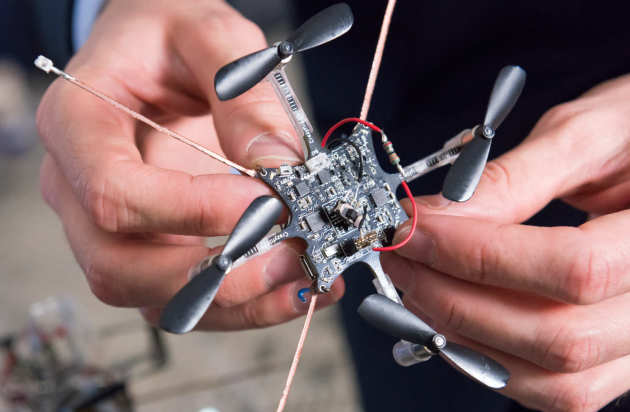The President's Excellence Fund for Frontier Research
The President's Excellence Fund for Frontier Research
 The College’s Strategy 2020-25 encourages us to act courageously and innovatively when pursuing new partnerships and opportunities and sets out our intention to invest funds and pursue the new and the risky. The President`s Excellence Fund for Frontier Research has been established to support research ideas could be breakthrough programs that have the potential to put us in a leadership position, even if the ideas have not yet received outside funding. Frontier research is intrinsically risky, often characterised by the absence of, or ability to expand disciplinary boundaries, resulting in a new understanding of basic research. For more infomation about the College’s Strategy view the College’s Strategy 2020-25 webpage.
The College’s Strategy 2020-25 encourages us to act courageously and innovatively when pursuing new partnerships and opportunities and sets out our intention to invest funds and pursue the new and the risky. The President`s Excellence Fund for Frontier Research has been established to support research ideas could be breakthrough programs that have the potential to put us in a leadership position, even if the ideas have not yet received outside funding. Frontier research is intrinsically risky, often characterised by the absence of, or ability to expand disciplinary boundaries, resulting in a new understanding of basic research. For more infomation about the College’s Strategy view the College’s Strategy 2020-25 webpage.
The President's Excellence Fund for Frontier Research is now open to applications. Funding will be available to support two grants, up to £250K each, for a duration of three years. There are no limits on in any individual spend category. Funds can be used to support salary, consumables, professional services, travel and subsistence and equipment. One grant will be awarded in each of two categories, an open competition, open to all academics, and an early career competition, for which the PI must be a Lecturer at the time of application.
Applications are made by Departments, who are permitted to submit one application to each competition category. Applications should be submitted by the Head of Department or their delegate to researchoffice.fundingstrategy@imperial.ac.uk by 1700 Wednesday 20 March 2024.
Applications will be largely forward looking, demonstrating an opportunity for 1) growth of an otherwise underdeveloped research area, 2) diversification into a new research area, or 3) new insight into a well-established research question.
For any further questions please contact Dr Mark Bambury at researchoffice.fundingstrategy@imperial.ac.uk
| Year | Awardees | Title of Project |
|---|---|---|
| Year 1 | Professor Guy-Bart Stan, Dr John Heap and Dr Connor Myant | A novel “true 3D” bio-manufacturing platform unlocking new classes of functional materials and structures with broad applications |
| Year 1 | Dr Marina Kuimova, Professor Ramon Vilar and Dr Jean-Baptiste Vannier | Imaging G-quadruplex DNA in live cells with small molecule optical probes |
| Year 1 | Professor Mike Warner and Professor Mengxing Tang | TRUST+FWI (Transmission and Reflection UltraSound Tomography with Full-Waveform Inversion) |
| Year 2 | Dr Paul Bruce and Dr Matthew Santer | Packing for a Journey to Mars |
| Year 2 | Professor Anastasios Karadiitris, Dr Antonia Rotolo, Dr Sarah Fidler and Profesor Graham Cooke | CAR-iNKT cell immunotherapy for the treatment of HIV Infection |
| Year 2 | Professor Jane Mitchell and Dr Nicholas Kirkby | Exploring the unchartered territory of the bronchovascular bundle to uncover new biological concepts and novel therapeutic targets for cardiovascular and respiratory disease |
| Year 3 | Dr Karen Polizzi, Dr Chris Rowlands and Dr Cleo Kontoravdi | Integrating living analytics into bioprocessing |
| Year 3 | Dr Ben Almquist, Dr Chris Rowlands and Dr Andriy Kozlov | Sensing voltage in neurons with biomimetic quantum-dot nano-doughnuts |
| Year 3 | Dr Minh-Son Pham and Dr Paul Hooper | Meta-crystals: Smart architected materials containing hierarchical crystals across multiple lengthscales |
| Year 4 | Professor Kevin Buzzard | Doing mathematics rigorously |
| Year 4 | Dr Fang Xie | Next Generation Plasmonic Enhanced Downconversion Nanoprobes (PEDN) with Exceptional Brightness for Cancer Imaging |
| Year 4 | Dr Giovanni Sena, Dr Connor Myant, Dr Gunnar Pruessner and Professor Chris Braddock | A novel bio-hybrid module for vertical and micro-gravity farming |
| Year 5 | Professor Will Branford, Professor Rupert Oulton and Dr Jack Gartside | Laser-controlled magnetoplasmonic nanoarrays for neuromorphic hardware |
| Year 5 | Dr Robert Hoye, Professor Rongjun Chen, Dr Peter Petrov, Professor Jerry Heng and Professor Peter Haynes | Precision Manufacturing of Large-Area Nanoporous Packaging for Stable Vaccines |
| Year 5 | Professor Mark Crimmin, Dr Becky Greenaway, James Bull and Professor Oscar Ces | Molecular Editing of Aromatic Rings |
| Year 6 | Dr Malcolm Connoly | Topological Quantum Computation and the Search for Majorana Fermions" |
| Year 6 | Dr Laura Barter, Dr Rudiger Woscholski, Professor Nick Long and Professor Oscar Ces | The World's First Catalytic Fertiliser (CENUP) |
| Year 6 | Professor Alexandra Porter, Dr Theoni Georgiou, Professor Mary Ryan, Professor Terry Tetley, Professor Omar Usmani, Professor Brian Robertson and Professor Robert J Wilkinson | Aerosolised Microparticle Drugs to Treat Pulmonary Tuberculosis |


